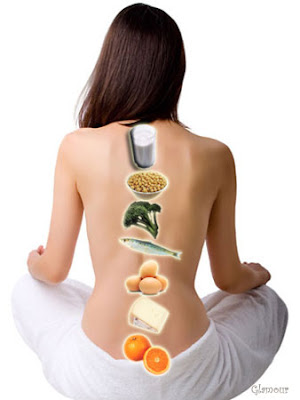Osteoporosis Vitamins
The patient Reported
What is Osteoporosis
 |
| Osteoporosis and Vitamin D |
Osteoporosis is a chronic, progressive disease characterized by decreased bone mass and bone deterioration. The bone is removed and replaced continuously throughout life, through a process called? Bone remodeling?. In women, after menopause, the activity of the cells that remove bone (osteoclasts) is higher than that produced it (osteoblasts), so that progressively lose bone mass and strength and are more likely to break or fracture. This is what is known as' osteoporosis ?.
What are its causes
1. Although the hormonal changes of menopause significantly increases their risk of osteoporosis in women, other factors may also contribute to the onset of the disease.
2. Vitamin D deficiency may contribute to the development and worsening osteoporosis. A low vitamin D can lead to poor absorption of calcium and the inability to suppress parathyroid hormone, which leads to a greater degree of bone resorption (the process of removing the bone), a decrease of bone mineral density (BMD) and increased risk of fracture. In recent years we have accumulated enough data to demonstrate the importance of vitamin D has time to avoid excessive loss of bone mass that occur because of age and to recognize their important role on muscle function, as says Dr. Esteban Jodar, coordinator of the Spanish Summit on the Role of vitamin D in the Management of Osteoporosis.
3. A sedentary lifestyle, snuff consumption, family history, excessive alcohol consumption, inadequate nutrition and steroid medication use also contribute to increased risk of fractures. Studies also suggest that Caucasian or Asian descent, the small or slim physique and early menopause (before age 45 years) are also risk factors for the disease.
Can it be Prevented ?
To prevent this condition, it is necessary to maintain adequate levels of vitamin D because of an insufficient level of this vitamin can lead to poor absorption of calcium, causing a decrease in bone mineral density (BMD) and favors fractures, main consequence of osteoporosis. The main source of vitamin D is sunlight. However, skin formation can be impaired by various causes, including the season, geographic latitude and skin pigmentation (the whiter the skin, the vitamin D made). Also, as people age, reduces the skin's ability to convert sunlight into vitamin D and the kidney to convert the vitamin into its active form. Unlike what happens with calcium, vitamin D is not easily obtained through food. This vitamin is found naturally in only a small number of foods such as egg yolks, liver, oysters and some fish are high in fat



